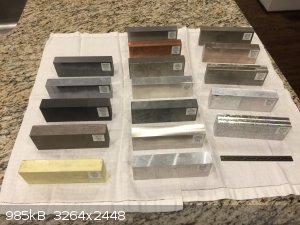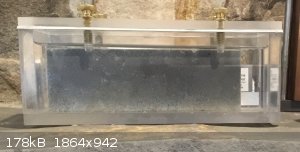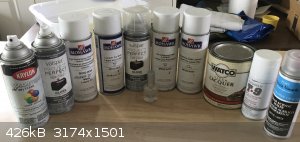
Bill Kahn - 10-5-2021 at 09:33
Hi.
I am brand new here. My name is Bill Kahn. A long time ago I majored in physics. Never understood chemistry.
Over the years I have slowly been collecting 1" x 2" x 6" bars of elements. I now have 18 of them on the mantle. See the attached snapshot for a
pretty recent photo.
I stumbled into a can of strontium. I had not realized how very very reactive in air it is. Gets physically warm and oxidizes at about one
millimeter of surface depth an hour. The white oxide irritates the nasal passages.
I figured out that keeping it under mineral spirits kept it stable. With much difficulty I isolated the pieces from the atmosphere, and heated them
up and let them melt into an oversized 1x2x6 steel mold. With more difficulty I cut away the mold and machined the raw bar to a respectable 1x2x6
bar. All while keeping it drenched in oil to keep it away from the atmosphere.
I now keep it in mineral spirits in an oversized 1x2x6 plexiglass box. It is visually there. And you can take the lid off and handle it for a few
minutes, until the spirits start to evaporate off, and you see the white powder starting to form. Then you need to dunk it again.
Anyway, it all sort of works. But not nicely.
You'll see in the snapshot that I have a bar of sulfur. It melts nicely. And (with effort) I figured out how to machine it to a respectable 1x2x6
bar. And then I coated it with polycrylic. Six layers. So, the bar no longer smells. (I have been told many times that sulfur does not smell, but
its compounds do. So, I need to isolate it from the living room in its little plastic cocoon.) Works pretty well.
So, finally, to my question. I would like to coat the strontium bar in some similar clear coating. That way I don't have a tub of mineral spirits on
the mantel. The coating 1) needs to be clear 2) needs to be air tight 3) cannot react with the strontium.
I have now tried a dozen different coatings. All of them react with the strontium. Including polyurethane and clear epoxy. I have tried several
hard waxes (not all that clear) and they react too (or are slightly permeable--I haven't bothered to figure out which.) And every time I see some
company selling some new spray coating I buy a can and try to protect a test piece. See snapshots for some of the candidates. None have worked.
So, all you chemists out there, any suggestions for a clear coating that will not react with strontium?
Thank you much.
Cordially,
Bill



zed - 11-5-2021 at 09:23
Bill, there are times when you don't get what you want.
You could machine the Strontium to exact dimensions, and press it into a glass or sapphire container, then seal it.
You might have limited success in "Boxing" it, with something like Microscope Slides, and shrink-wrapping the whole parcel.
But, since this is gonna happen a few more times with other Elements, it might just be easier to devise an alternate storage form for your "problem
children".
Lithium, Sodium, Potassium.... And Mercury, are going to be equally troublesome.
[Edited on 11-5-2021 by zed]
TheMrbunGee - 11-5-2021 at 10:35
Since You are melting it anyway, maybe You can melt it into a glass box?
unionised - 11-5-2021 at 11:08
It's a long shot, but I wonder if pure styrene resin would work.
It's a hydrocarbon, so it's not going to react readily.
The problem would be that the usual initiator is benzoyl peroxide. But you don't need much.
It's possible that the strontium itself would generate enough free radicals to get the reaction started.
Once it's coated with polystyrene, you can pot it in some other clear resin.
Lion850 - 11-5-2021 at 11:38
Impressive collection! I like it.
Fantasma4500 - 19-5-2021 at 07:02
impressive, straight edges, the ideal metal collection. but with that kind of collection you need to polish it up every now and then, steel wool
attached to a rotating tool should do plenty and i believe coating it with some silicone oil would keep it from corroding too easily, im myself hoping
to have a 10kg wolfram cube and have a petty hobby with machining the biggest steel cube i can get to- so far im at about 120mm, it has to be cut from
one solid chunk of steel
as for the strontium, you may have to shield it up with something that forms an inert surface layer, usually you can coat perfectly clean steel with a
very vague mist of clear spray lacquer and then throwing pressurized air on that immediatedly to have it dry same second, you might have to try that
as for polystyrene, i recall melting some polystyrene on a stainless steel plate, it would not come off no matter how hard i scraped, it perfectly
annealed, maybe you should try melting some polystyrene on the surface of the bar immersed in a pot with argon atmosphere? only devil that came close
to how well that PS stuck was sodium silicate that formed a layer of glass in one of my pots
Bezaleel - 20-5-2021 at 15:24
Polystyrene has been mentioned before. I worked many times with it. Instead of benzoyl peroxide, MEK is also used. In addition, it often contains a
cobalt compound to accelerate curing. If you try, I would seek for a polystyrene resin without cobalt or other accelerator. You might consider putting
on an initial layer of just PS resin and then brushing PS with hardener over it.
Another idea might be the use of resins which have been traditionally used as patina. Clear shellac, Damar resin and Carnauba wax come to mind.
Shellac is soluble in ethanol (or IPA), which will not immediately react with calcium link and so I neither expect them to react immediately with strontium. If you have a thin layer of shellac on it, you could use a different,
permanent and harder final protective layer.
Good luck!
